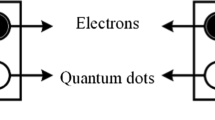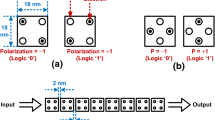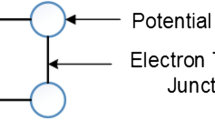Abstract
The difficulty of manufacturing and noise sensitivity of quantum-dot cellular automata (QCA) make wire-crossings optimization increasingly important. Novel logic primitives such as majority-of-five (MAJ5) and XOR-of-three (XOR3) with efficient QCA realizations can alleviate the wire-crossings issue. In this paper, we aim at 13 standard three-input Boolean functions, the QCA layouts of which are designed by introducing MAJ5 (Method A) and its combinations with XOR3 (Method B). The proposed designs are verified by the QCADesigner tool. Experimental results show we can reduce the number of QCA cells and area. In terms of area, we can achieve 30.69% and 48.35% reduction by Method A and B, respectively, compared with the state-of-the-art approach. The proposed designs are further used as building blocks for large-scale circuit designs. In one implementation, the Peres reversible gate is implemented based on Method B to decrease the area by 33.3%.











Similar content being viewed by others
Availability of data and materials
All data generated or analyzed during this study are included in this published article.
References
Khouri, K.S., Jha, N.K.: Leakage power analysis and reduction during behavioral synthesis. IEEE Transactions on Very Large Scale Integration (VLSI) Systems 10(6), 876–885 (2002)
Chiang, M.H., Kim, K., Chuang, C.T., Tretz, C.: High-density reduced-stack logic circuit techniques using independent-gate controlled double-gate devices. IEEE Transactions on Electron Devices 53(9), 2370–2377 (2006)
Heydari, M., Xiaohu, Z., Lai, K.K., Afro, S.: A cost-aware efficient ram structure based on quantum-dot cellular automata nanotechnology. Int. J. Theor. Phys. 58(12), 3961–3972 (2019)
Lent, C.S., Tougaw, P.D., Porod, W., Bernstein, G.H.: Quantum cellular automata. Nanotechnology 4(1), 49 (1993)
Timler, J., Lent, C.S.: Power gain and dissipation in quantum-dot cellular automata. Journal of Applied Ahysics 91(2), 823–831 (2002)
Nejad, S.M., Kakhki, F.A., Rahimi, E.: A simple mathematical model for clocked QCA cells. In: IEEE 2010 7th International Symposium on Communication Systems, Networks & Digital Signal Processing (CSNDSP 2010), pp. 351–354 (2010)
Chaudhary, A., Chen, D.Z., Hu, X.S., Niemier, M.T., Ravichandran, R., Whitton, K.: Fabricatable interconnect and molecular QCA circuits. IEEE Transactions on Computer-Aided Design of Integrated Circuits and Systems 26(11), 1978–1991 (2007)
Taherifard, M., Fathy, M.: Improving logic function synthesis, through wire crossing reduction in quantum-dot cellular automata layout. IET Circuits, Devices & Systems 9(4), 265–274 (2015)
Chaudhary, A., Chen, D.Z., Hu, X.S., Niemier, M.T., Ravichandran, R., Whitton, K.: Fabricatable interconnect and molecular QCA circuits. IEEE Transactions on Computer-Aided Design of Integrated Circuits and Systems 26(11), 1978–1991 (2007)
Abedi, D., Jaberipur, G., Sangsefidi, M.: Coplanar full adder in quantum-dot cellular automata via clock-zone-based crossover. IEEE Trans. Nanotechnol. 14(3), 497–504 (2015)
Tahmasebi, M., Mirzaee, R.F., Komleh, S.H.P.: On the design methodology of boolean functions with quantum-dot cellular automata for reducing delay and number of wire crossings. J. Comput. Electron. 17(4), 1756–1770 (2018)
Liu, W., Swartzlander, E.E., O’neill, M.: Design of Semiconductor QCA systems. Artech House (2013)
Snider, G., Orlov, A., Amlani, I., Bernstein, G., Lent, C., Merz, J., Porod, W.: Quantum-dot cellular automata: line and majority logic gate. Jpn. J. Appl. Phys. 38(12S), 7227–7229 (1999)
Mitic, M., Cassidy, M.C., Petersson, K.D.: Demonstration of a silicon-based quantum cellular automata cell. Appl. Phys. Lett. 89(1), 013503 (2006)
Wolkow, R.A., Livadaru, L., Pitters, J.: Silicon atomic quantum dots enable beyond-CMOS electronics. In: Field-Coupled Nanocomputing, pp. 33–58. Springer, Berlin (2014)
Lieberman, M., Chellamma, S., Varughese, B.: Quantum-dot cellular automata at a molecular scale. Ann. N. Y. Acad. Sci. 960(1), 225–239 (2002)
Bernstein, G.H., Imre, A., Metlushko, V.: Magnetic QCA systems. Microelectron. J. 36(7), 619–624 (2005)
Hu, X.K., Dey, H., Liebing, N.: Edge-mode resonance-assisted switching of nanomagnet logic elements. IEEE Trans. Magn. 51(11), 1–4 (2015)
Lent, C.S., Henderson, K.W.: Molecular cellular networks: a non von Neumann architecture for molecular electronics. In: IEEE 2016 International Conference on Rebooting Computing, pp. 1–7 (2016)
Bohloul, S., Shi, Q., Wolkow, R.A.: Quantum transport in gated dangling-bond atomic wires. Nano Lett. 17(1), 322–327 (2017)
Amlani, I., Orlov, A.O., Toth, G., Bernstein, G.H., Lent, C.S., Snider, G.L.: Digital logic gate using quantum-dot cellular automata. Science 284(5412), 289–291 (1999)
Liu, W., Lu, L., O’Neill, M., Swartzlander, E.E.: A first step toward cost functions for quantum-dot cellular automata designs. IEEE Trans. Nanotechnol. 13(3), 476–487 (2014)
Rajeswari, D., Paul, K., Balakrishnan, M.: Clocking-based coplanar wire crossing scheme for QCA. In: IEEE 2010 23rd International Conference on VLSI Design, pp. 339–344 (2010)
Bhanja, S., Ottavi, M., Lombardi, F., Pontarelli, S.: QCA circuits for robust coplanar crossing. J. Electron. Test. 23(2), 193–210 (2007)
Labrado, C., Thapliyal, H.: Design of adder and subtractor circuits in majority logic-based field-coupled QCA nanocomputing. Electron. Lett. 52(6), 464–466 (2016)
Dysart, T.J., Kogge, P.M.: Probabilistic analysis of a molecular quantum-dot cellular automata adder. In: IEEE 2007 22nd International Symposium on Defect and Fault-Tolerance in VLSI Systems, pp 478–486 (2007)
Angizi, S., Sarmadi, S., Sayedsalehi, S., Navi, K.: Design and evaluation of new majority gate-based RAM cell in quantum-dot cellular automata. Microelectron. J. 46(1), 43–51 (2015)
Kassa, S.R., Nagaria, R.: A novel design of quantum dot cellular automata 5-input majority gate with some physical proofs. J. Comput. Electron. 15 (1), 324–334 (2016)
Sasamal, T.N., Singh, A.K., Mohan, A.: An optimal design of full adder based on 5-input majority gate in coplanar quantum-dot cellular automata. Optik 127(20), 8576–8591 (2016)
Sasamal, T.N., Singh, A.K., Mohan, A.: An efficient design of quantum-dot cellular automata based 5-input majority gate with power analysis. Microprocess. Microsyst. 59, 103–117 (2018)
Majeed, A.H., AlKaldy, E., Zainal, M., Nor, D.B.: A new 5-input majority gate without adjacent inputs crosstalk effect in QCA technology. Indonesian Journal of Electrical Engineering and Computer Science 14(3), 1159–1164 (2019)
Deng, F., Xie, G., Wang, S., Cheng, X., Zhang, Y.: An ultra-low-power five-input majority gate in quantum-dot cellular automata. Journal of Circuits, Systems and Computers 29(11), 2050176 (2020)
Soeken, M., Amaru, L.G., Gaillardon, P.E., De Micheli, G.: Exact synthesis of majority-inverter graphs and its applications. IEEE Transactions on Computer-Aided Design of Integrated Circuits and Systems 36(11), 1842–1855 (2017)
Chu, Z., Haaswijk, W., Soeken, M., Xia, Y., Wang, L., De Micheli, G.: Exact synthesis of boolean functions in majority-of-five forms. In: IEEE 2019 International Symposium on Circuits and Systems (ISCAS), pp. 1–5 (2019)
Háleček, I., Fišer, P., Schmidt, J.: Are XORs in logic synthesis really necessary?. In: 2017 IEEE 20th International Symposium on Design and Diagnostics of Electronic Circuits & Systems (DDECS), pp. 134–139 (2017)
Ahmad, F., Bhat, G.M., Khademolhosseini, H., Azimi, S., Angizi, S., Navi, K.: Towards single layer quantum-dot cellular automata adders based on explicit interaction of cells. J. Comput. Sci. 16, 8–15 (2016)
Bahar, A.N., Waheed, S., Hossain, N., Asaduzzaman, M.: A novel 3-input XOR function implementation in quantum dot-cellular automata with energy dissipation analysis. Alexandria Engineering Journal 57(2), 729–738 (2018)
Balali, M., Rezai, A., Balali, H., Rabiei, F., Emadi, S.: Towards coplanar quantum-dot cellular automata adders based on efficient three-input XOR gate. Results in Physics 7, 1389–1395 (2017)
Kalpana, K., Paulchamy, B., Chinnapparaj, S., Mahendrakan, K., AbdulHayum, A.: A novel design of nano scale tieo based single layer full adder and full subractor in QCA paradigm. In: IEEE 2021 5th International Conference on Intelligent Computing and Control Systems (ICICCS), pp. 575–582 (2021)
Chung, W.J., Smith, B., Lim, S.K.: Node duplication and routing algorithms for quantum-dot cellular automata circuits. IEEE Proceedings-Circuits Devices and Systems 153(5), 497–505 (2006)
Smith, B.S., Lim, S.K.: QCA channel routing with wire crossing minimization. In: Proceedings of the 15th ACM Great Lakes Symposium on VLSI, pp. 217–220 (2005)
Bubna, M., Roy, S., Shenoy, N., Mazumdar, S.: A layout-aware physical design method for constructing feasible QCA circuits. In: Proceedings of the 18th ACM Great Lakes Symposium on VLSI, pp. 243–248 (2008)
Nath, R.K., Sen, B., Sikdar, B.K.: Optimal synthesis of QCA logic circuit eliminating wire-crossings. IET Circuits, Devices & Systems 11(3), 201–208 (2017)
Sen, B., Sengupta, A., Dalui, M., Sikdar, B.K.: Design of testable universal logic gate targeting minimum wire-crossings in QCA logic circuit. In: IEEE 2010 13th Euromicro Conference on Digital System Design: Architectures, Methods and Tools, pp. 613–620 (2010)
Sen, B., Dalui, M., Sikdar, B.K.: Introducing universal QCA logic gate for synthesizing symmetric functions with minimum wire-crossings. In: Proceedings of the International Conference and Workshop on Emerging Trends in Technology, pp. 828–833 (2010)
Zhang, R., Walus, K., Wang, W., Jullien, G.A.: A method of majority logic reduction for quantum cellular automata. IEEE Trans. Nanotechnol. 3(4), 443–450 (2004)
Benini, L., De Micheli, G.: A survey of boolean matching techniques for library binding. ACM Transactions on Design Automation of Electronic Systems (TODAES) 2(3), 193–226 (1997)
Peres, A.: Reversible logic and quantum computers. Phys. Rev. A 32(6), 3266 (1985)
Walus, K., Dysart, T.J., Jullien, G.A., Budiman, R.A.: QCADEsigner: a rapid design and simulation tool for quantum-dot cellular automata. IEEE Trans. Nanotechnol. 3(1), 26–31 (2004)
Tian, H.M., Chu, Z.F.: Inversion Optimization Strategy based on Primitives with Complement Attribute. J. Comput. Sci. Technol. 36(5), 1145–1154 (2021)
Funding
This work was supported in part by the National Natural Science Foundation of China (NSFC) under Grant 61871242; in part by the State Key Laboratory of ASIC & System under Grant 2021KF008; and in part by the Scientific Research Project of the Department of Education of Zhejiang under Grant Y202045495.
Author information
Authors and Affiliations
Contributions
P. Liu proposed the logic expressions for 13 standard three-input Boolean functions, and J. Ni simulated and verified the proposed designs using QCADesigner. P. Liu and Z. Chu contribute to the writing. The final manuscript was read and approved by all authors.
Corresponding author
Ethics declarations
Conflict of Interests
The authors declare that they have no competing interests.
Additional information
Publisher’s Note
Springer Nature remains neutral with regard to jurisdictional claims in published maps and institutional affiliations.
Appendices
Appendix A: QCA Layouts of of 13 Standard with Method A
Appendix B: QCA Layouts of of 13 Standard with Method B
Rights and permissions
About this article
Cite this article
Liu, P., Ni, J. & Chu, Z. Wire-Crossings Optimization Based on Majority-of-Five and XOR-of-Three Primitives in QCA. Int J Theor Phys 61, 86 (2022). https://doi.org/10.1007/s10773-022-05000-5
Received:
Accepted:
Published:
DOI: https://doi.org/10.1007/s10773-022-05000-5






